The summer sunlight lingers long into the evening on the Qinghai-Tibet Plateau. Sonam Drolma, a 31-year-old Tibetan herdswoman from Shangtamai village, Chabucha township, Gonghe county, negotiates a motorcycle through the gaps among a sea of dark blue photovoltaic panels, driving her sheep back to the circle for water, in the Talatan Photovoltaic Industry Park in Gonghe county, Hainan Tibetan autonomous prefecture, Northwest China's Qinghai province.
Herding sheep among photovoltaic panels is an unintentional positive outcome for the herdsmen. In 2012, the prefecture government began to install China's first 10 million kilowatt-class solar power generation base in Talatan (Tala sand land). Ten years later, the photovoltaic park there covers an area of 609 square kilometers, which is close to the land area of Singapore. With the installed 8,430 megawatts, the park tops the chart with the largest photovoltaic power generation capacity in the world.
Talatan is nearly 3,000 meters above sea level. This means that it is pummeled with radiation from the sun which is not suitable for plant growth. It was an ambitious plan by the local government to build a photovoltaic power station there, as the original desertification rate was up to 98.5 percent. The panels are prone to damage by the sand and gravel disturbed up by the strong gusts of wind. Grass seeds have been heavily planted in the base to stop the sand from being blown away.
The locals took a dim view of the grass growing, let alone thriving, in such a barren place. Unexpectedly, the grass here has kept growing prolifically, and the photovoltaic panel park has turned into an oasis. "The laying of photovoltaic panels reduces the wind erosion on vegetation. The water we use for daily cleaning of photovoltaic panels infiltrates beneath the surface, which has a certain nourishing effect on the grass," says Zhu Mingcheng, general manager of the Hainan branch of the Yellow River Hydropower Co.
The grass grows and the sand settles, but new challenges arise. The grass grows haphazardly, blocking the photovoltaic panels, reducing their conversion rate, and literally, stacking up fire hazards in winter. The staff have tried manual weeding, spraying herbicides, and even thinking about raising the photovoltaic panels, but they could not fully solve the dilemma. And then nature, as is so often the case, came up with its own solution.
"Rather than paying someone to mow the grass, it's better to let herdsmen put their sheep here," says Zhu as he recalled his flash of "inspiration" at that time. The park invited the surrounding villagers to raise "photovoltaic sheep". They built four sheep pens for free, so that the "photovoltaic shepherd" could start their "old business" at zero cost.
Sonam is among the many herdspersons who have agreed to drive their flocks to the park to graze. The grass here is enough to feed the sheep, and the shadow cast by the photovoltaic panels is especially suitable for the sheep to rest in the shade. Manure can serve as a natural fertilizer for the grass. Speaking of the biggest difference in sheep herding today, Sonam says, "The sheep eat well and they have a higher survival rate. Now my flock has doubled in number, and my annual income has increased by 40,000 to 50,000 yuan ($5,960-7,450)."
In addition to being a "photovoltaic shepherd", villagers can also expand their income sources by cleaning photovoltaic modules, mowing grass, and handling cargo in the park.
The photovoltaic power station in Talatan not only provides clean energy, but also attracts herdsmen to return, creating a cycle of activity that improves the ecological environment on the Gobi Desert. "It kills three birds with one stone," says Zhang Zhenfei, director of the energy bureau of Hainan Tibetan autonomous prefecture. "The current Talatan not only has an average annual power generation of 80 million kilowatt-hours, but also achieves a 50 percent reduction in wind speed in the park, a 30 percent reduction in soil moisture evaporation, and a recovery of vegetation coverage of 80 percent. With the desertification of the land curbed, the annual output of pasture has reached 110,000 tonnes, and the number of 'photovoltaic sheep' has reached more than 20,000."
高原夏日的傍晚,光照依旧强烈。2022年7月6日,青海省海南藏族自治州共和县的塔拉滩光电园区,恰卜恰镇上塔迈村31岁的藏族牧民索南卓玛骑着摩托车穿行在深蓝色的光伏板间,驱赶着羊群回圈饮水。
在光伏板里放羊,是个“无心插柳柳成荫”的故事。2012年,海南州在塔拉滩开始修建我国第一个千万千瓦级太阳能发电基地。10年后,塔拉滩的光伏园占地面积达到609平方公里,接近新加坡的国土面积;光伏发电装机容量为8430兆瓦,目前是全球最大装机容量的光伏发电园区。
塔拉滩海拔将近3000米,阳光辐射强烈,特别不适合植物生长,原本的荒漠化率高达98.5%,所以才选在这里建光伏电站。塔拉滩的风沙大,光伏板很容易被大风卷起来的沙石损坏,工作人员在基地里撒了不少草籽,用来防风固沙。
按说在这么贫瘠的地方,草不可能长得太好。没想到的是,这里的草却一个劲儿疯长,光伏板下面成了一片绿油油的草原。“光伏板的铺设,减少了风对植被的影响,我们日常清洗光伏板的水会下渗至地表,这对草地有一定滋养作用。”黄河水电公司海南分公司总经理朱明成说。
草长起来了,沙也固住了,但新麻烦也随之而来——草杂乱无章的生长,遮挡住了光伏板,降低了光伏板发电的转化率,并且冬天还存在火灾隐患。工作人员试过人工除草、洒除草剂,甚至想过干脆把光伏板架高,但都不能从根本上解决问题。
“与其花钱雇人来割草,还不如让牧民来放羊。”朱明成回忆当时的“灵机一动”。园区邀请周边村民进入光伏园养起“光伏羊”,“我们免费修建了4座羊圈,让‘光伏羊倌’零成本干起‘老本行’。”
索南卓玛就这样把自家的羊群赶到了园区放牧。这里的草足够喂羊,光伏板的阴影也特别适合羊群休息,而羊粪又能成为草的天然肥料。说起如今放羊最大的不同,索南卓玛说:“羊吃得好,成活率也更高了,现在我的羊群数量比之前翻了一倍,年收入增加了四五万元。”此外,除了当“光伏羊倌”,村民还能在园区通过清洗光伏组件、割草、货物搬运等方式拓宽收入渠道。
塔拉滩的光伏电站既提供了清洁能源,又吸引了牧民回归,还改善了戈壁的生态环境,可以说是一举三得。海南藏族自治州能源局局长张振飞说,“现在的塔拉滩不仅有8000万度的年均发电量,还实现了园区风速降低50%、土壤水分蒸发量减少30%、植被覆盖也恢复到80%,土地荒漠化得到遏制,每年的牧草产量达到11万吨,存栏的“光伏羊”达到两万多只。”

In the Talatan Photovoltaic Industry Park in Gonghe county, Hainan Tibetan autonomous prefecture, Northwest China's Qinghai province, herdsmen driving their sheep back to the sheepfold for water.
2022年7月6日,青海省海南藏族自治州共和县的塔拉滩光电园区,牧民驱赶着羊群回羊圈饮水。

Yang Ruoyi, an employee from the Longyangxia Hydro-Solar Hybrid Power Station, elaborating on the ecological improvement of the Gobi Desert.
龙羊峡水光互补发电站的讲解员杨若怡介绍沙漠戈壁生态向好的经过。
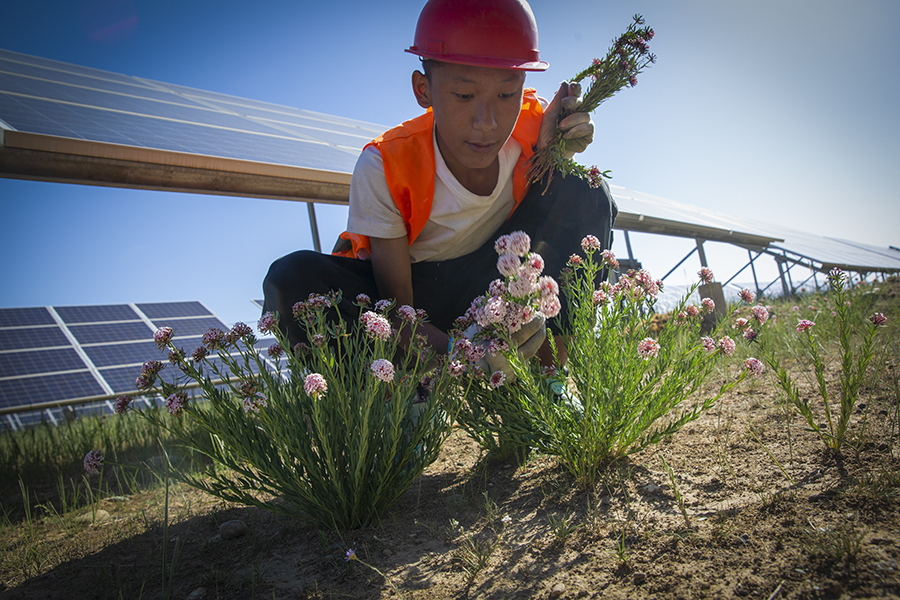
An 18-year-old Tibetan making ends meet by working as a temporary worker in the park.
18岁藏族小伙杨青东在塔拉滩光伏园区打临时工创收。
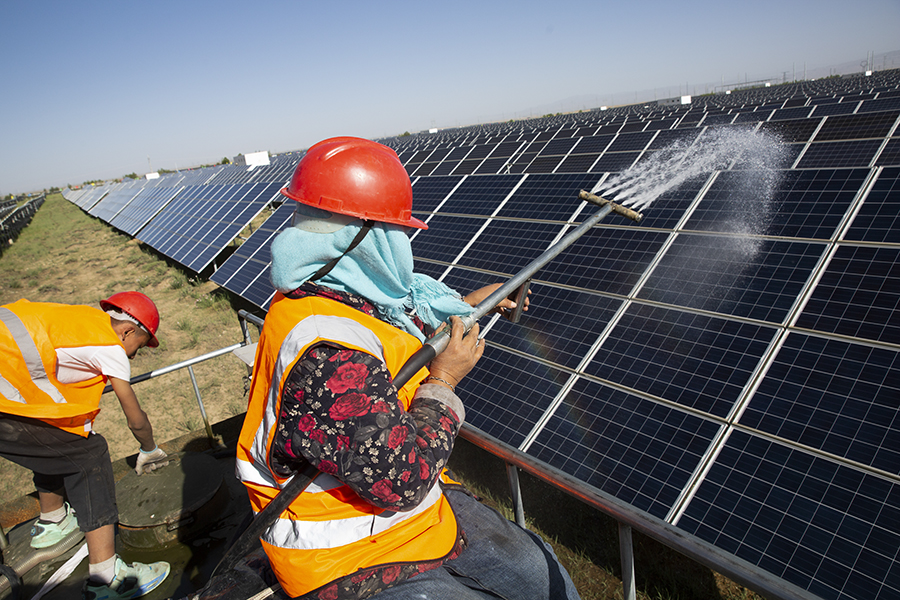
The staff in the Talatan Photovoltaic Industry Park cleaning the photovoltaic panels.
工作人员在塔拉滩光伏园区内清洗光伏板。
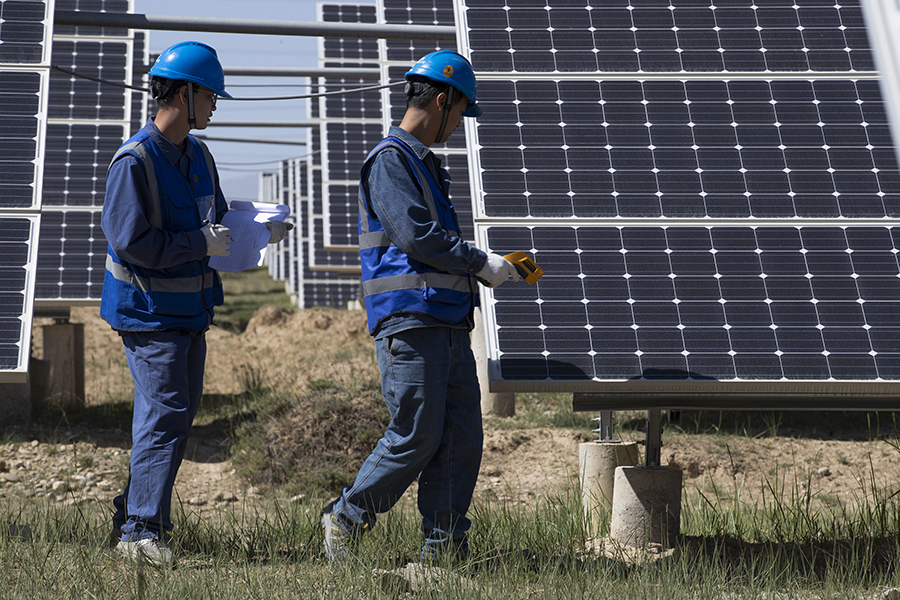
Yu Yang, 32, and his colleague conducting photovoltaic maintenance work.
维检工于洋(32岁,右)和同事进行光伏维护作业。

Herdswoman Sonam Drolma riding a motorcycle to herd sheep among the photovoltaic panels.
牧民索南卓玛骑着摩托车在光伏板里牧羊。
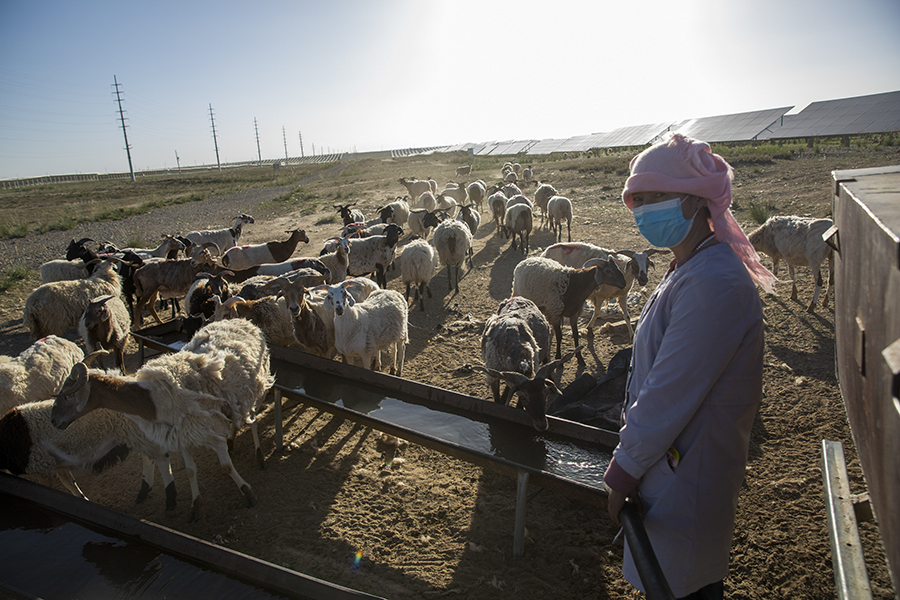
Herdswoman Sonam Drolma watering the sheep in the pasture.
索南卓玛在牧场给羊群饮水。
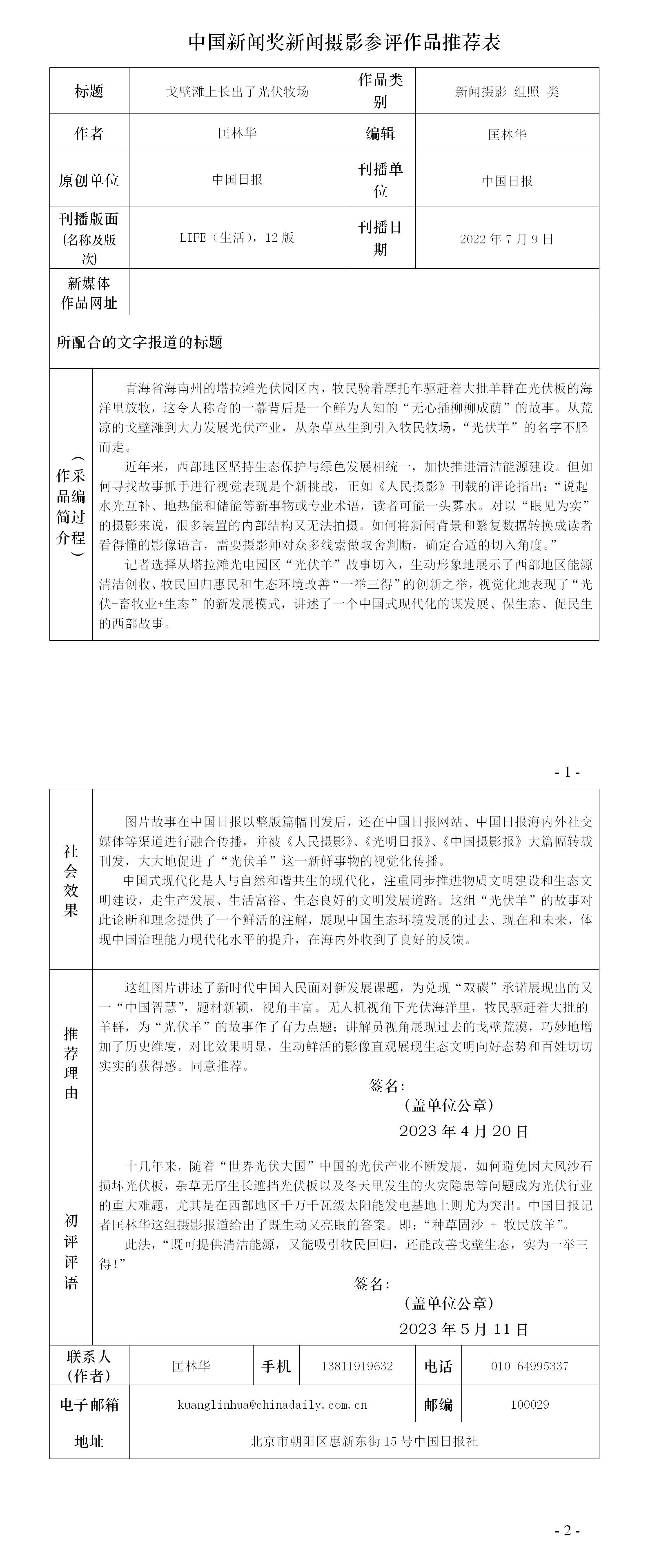
关于我们 - 版权声明 - 联系我们 投稿信箱:cnpressphoto@gmw.cn
京ICP备19055723号 Copyright ©cnpressphoto.com